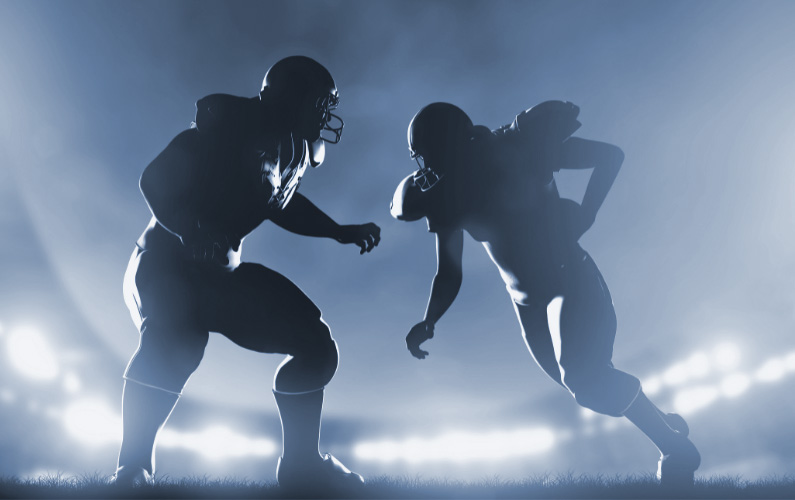- The Super Bowl is advertising’s biggest stage, with advertisers jockeying to get their products in front of the more than 100 million people that watch each year.
- Our media analysis found that alcohol emerged as a new competitive arena, while the most influential company in the debate around the game was Heineken, which made history by advertising the first non-alcoholic beer in Super Bowl’s history.
- Many media outlets also discussed how this year’s advertisers sent weak climate messages in comparison to last year, while the crypto industry had no presence at all.
View a one-page infographic summary of the analysis
This February, the stakes were high for Super Bowl advertisers. The Super Bowl still regularly draws an audience of around 100 million people, making it TV’s biggest event of the year and advertising’s biggest night.
Ads aired during the game also generate an enormous amount of media coverage, as journalists look at them as setting new trends for the foreseeable future. To see what stood out this year, we analysed 422 English-language articles published in top-tier outlets during the last month. Here are our main findings:
1. Alcohol brands were the biggest story
Beer ads are practically as characteristic of the Super Bowl as touchdowns. And they were again this year, with one big change: they didn’t all come from brands owned by Anheuser-Busch.
After three decades as the only alcohol brand to air its commercials nationally during the game, the parent company of Budweiser, Bud Light and Michelob Ultra gave up that exclusivity in June.
Cue the competitors — and a flood of beer and alcohol ads in the national broadcast, which in turn made the alcohol industry the most widely discussed one in the media debate:
According to many commentators, alcohol is now a new competitive arena in the Super Bowl. While Anheuser-Busch remained the biggest advertiser with three minutes of national airtime, others like Heineken, Diageo, Remy Martin and Molson Coors were also heavy in the game.
2. The first non-alcoholic Super Bowl ad put Heineken on top
Interestingly, the most prominent company in the media debate was Heineken, which earned its influence with a non-alcoholic beer ad.
Heineken attracted significant media attention when it said its 30-second Super Bowl ad for Heineken 0.0 was the first national commercial in the game for a nonalcoholic beer, putting a spotlight on the dry movement in booze.
The ad, featuring actor Paul Rudd as Marvel’s Ant-Man, aired ahead of the release of that character’s coming film, “Ant-Man and the Wasp: Quantumania.”
The commercial during U.S. television’s biggest event of the year is a chance to reach the younger consumers who are often drinking less alcohol, said Jonnie Cahill, chief marketing officer at Heineken USA. “That is not a trend; that’s not a fad,” Mr. Cahill said. “That’s a macro societal trend away from alcohol.”
3. Bud Light won over Twitter
Despite Heineken’s success in traditional media, it was an Anheuser-Busch brand – Bud Light – which won over Twitter users.
In the 30-second ad, Miles and Keleigh Teller turned the frustrating experience of being stuck on hold into a small dance party while cracking open a Bud Light.
The spot impressed Twitter users with a new degree of sophistication and even a female as one of the central characters.
If any brand’s voice has boomed in advertising, it is Bud Light’s. Over the decades, this is the beer that brought consumers party dog Spuds McKenzie; quirky odes to “Real Men of Genius”; a Super Bowl ad featuring young men praying to a “magic fridge” full of the brew; Cedric the Entertainer; and the Bud Knight. Marketers behind the beverage have launched so many characters to help sell it that in 2021, Bud Light ran a Super Bowl commercial celebrating all of them.
4. A climate letdown
Last year’s Super Bowl was a hotbed for advertisements focused on solving the climate crisis. This year, not so much.
There were three TV spots this year featuring electric cars, compared with seven during the 2022 broadcast. Beyond that, the climate pickings were slim — a single ad from mayonnaise producer Hellmann’s warning against food waste, which can spew planet-warming methane (not that the ad mentions this). Meanwhile, General Motors’ ad gently poked fun at its new deal to promote electric vehicles in Netflix shows.
Many publications noted that there was nothing like last year’s soaring Salesforce promo, featuring Matthew McConaughey as an astronaut returning to Earth to protect his home planet.
Moreover, the night’s most popular auto ad — at least according to Cars.com — was Kia’s “Binky Dad” commercial, which spotlights a gas guzzler. The Kia ad also shows a bunch of people driving through the Los Angeles River — an unfortunate Hollywood trope that portrays the river as more of a concrete channel than the natural, life-sustaining waterway it’s supposed to be.
5. Crypto was out
Last year’s Super Bowl was dubbed the “Crypto Bowl” because four cryptocurrency companies — FTX, Coinbase, Crypto.com and eToro — ran splashy commercials. It was part of a larger effort by crypto companies to break into the mainstream with sports sponsorships.
A number of media outlets noted that the reality couldn’t look more different since those crypto ads aired. Since the last Super Bowl, the crypto market has come crashing down. Bitcoin lost 60% of its value while the market as a whole had $2tn wiped off.
The very same companies that were flying high with expensive Super Bowl ads have now had to downsize and lay off staff. Crypto.com slashed a fifth of its headcount, while Coinbase had laid off over 2,000 employees in two separate rounds of cuts.

